Miruna Clinciu
On the Role of Summary Content Units in Text Summarization Evaluation
Apr 02, 2024



Abstract:At the heart of the Pyramid evaluation method for text summarization lie human written summary content units (SCUs). These SCUs are concise sentences that decompose a summary into small facts. Such SCUs can be used to judge the quality of a candidate summary, possibly partially automated via natural language inference (NLI) systems. Interestingly, with the aim to fully automate the Pyramid evaluation, Zhang and Bansal (2021) show that SCUs can be approximated by automatically generated semantic role triplets (STUs). However, several questions currently lack answers, in particular: i) Are there other ways of approximating SCUs that can offer advantages? ii) Under which conditions are SCUs (or their approximations) offering the most value? In this work, we examine two novel strategies to approximate SCUs: generating SCU approximations from AMR meaning representations (SMUs) and from large language models (SGUs), respectively. We find that while STUs and SMUs are competitive, the best approximation quality is achieved by SGUs. We also show through a simple sentence-decomposition baseline (SSUs) that SCUs (and their approximations) offer the most value when ranking short summaries, but may not help as much when ranking systems or longer summaries.
Needle in a Haystack: An Analysis of Finding Qualified Workers on MTurk for Summarization
Dec 28, 2022



Abstract:The acquisition of high-quality human annotations through crowdsourcing platforms like Amazon Mechanical Turk (MTurk) is more challenging than expected. The annotation quality might be affected by various aspects like annotation instructions, Human Intelligence Task (HIT) design, and wages paid to annotators, etc. To avoid potentially low-quality annotations which could mislead the evaluation of automatic summarization system outputs, we investigate the recruitment of high-quality MTurk workers via a three-step qualification pipeline. We show that we can successfully filter out bad workers before they carry out the evaluations and obtain high-quality annotations while optimizing the use of resources. This paper can serve as basis for the recruitment of qualified annotators in other challenging annotation tasks.
BLOOM: A 176B-Parameter Open-Access Multilingual Language Model
Nov 09, 2022Abstract:Large language models (LLMs) have been shown to be able to perform new tasks based on a few demonstrations or natural language instructions. While these capabilities have led to widespread adoption, most LLMs are developed by resource-rich organizations and are frequently kept from the public. As a step towards democratizing this powerful technology, we present BLOOM, a 176B-parameter open-access language model designed and built thanks to a collaboration of hundreds of researchers. BLOOM is a decoder-only Transformer language model that was trained on the ROOTS corpus, a dataset comprising hundreds of sources in 46 natural and 13 programming languages (59 in total). We find that BLOOM achieves competitive performance on a wide variety of benchmarks, with stronger results after undergoing multitask prompted finetuning. To facilitate future research and applications using LLMs, we publicly release our models and code under the Responsible AI License.
A Study of Automatic Metrics for the Evaluation of Natural Language Explanations
Mar 15, 2021

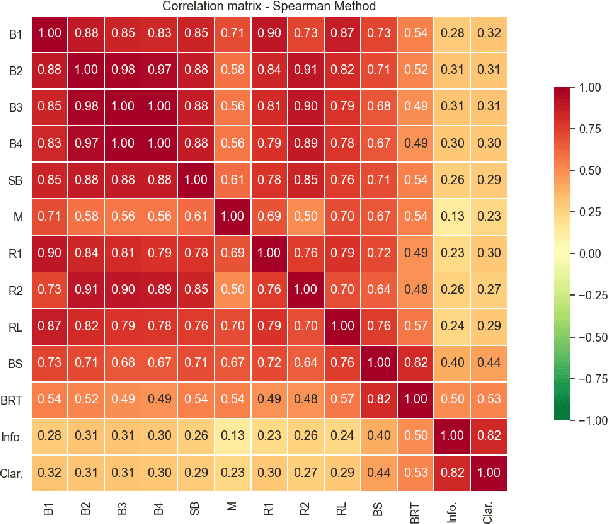
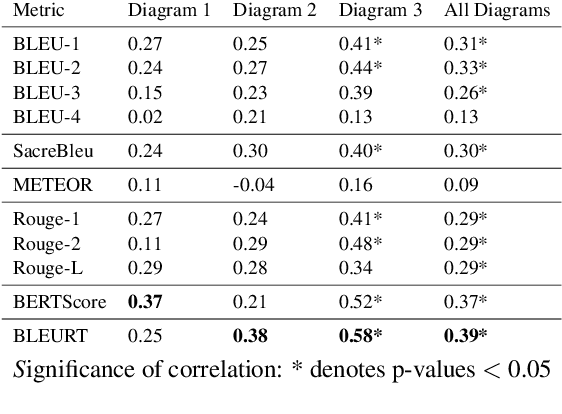
Abstract:As transparency becomes key for robotics and AI, it will be necessary to evaluate the methods through which transparency is provided, including automatically generated natural language (NL) explanations. Here, we explore parallels between the generation of such explanations and the much-studied field of evaluation of Natural Language Generation (NLG). Specifically, we investigate which of the NLG evaluation measures map well to explanations. We present the ExBAN corpus: a crowd-sourced corpus of NL explanations for Bayesian Networks. We run correlations comparing human subjective ratings with NLG automatic measures. We find that embedding-based automatic NLG evaluation methods, such as BERTScore and BLEURT, have a higher correlation with human ratings, compared to word-overlap metrics, such as BLEU and ROUGE. This work has implications for Explainable AI and transparent robotic and autonomous systems.
The GEM Benchmark: Natural Language Generation, its Evaluation and Metrics
Feb 03, 2021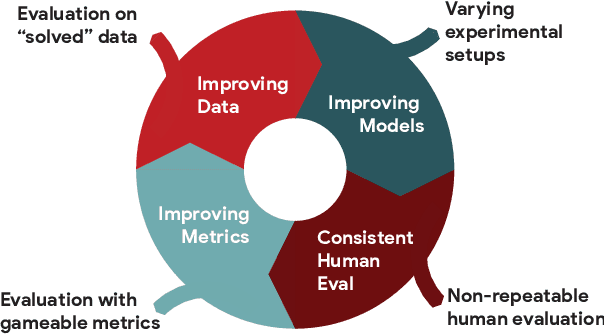
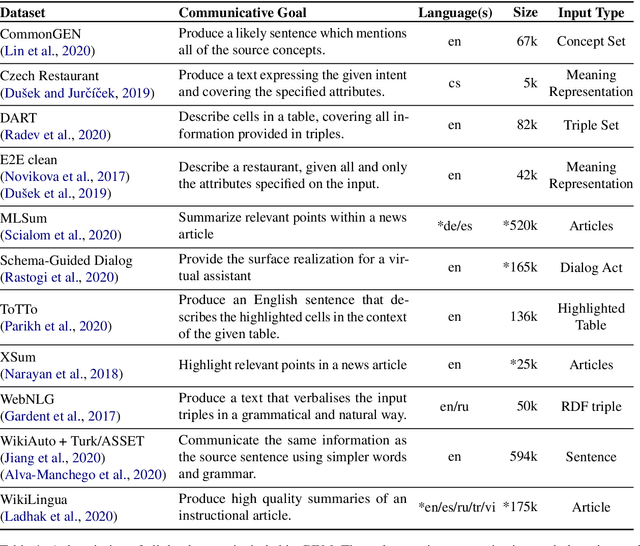
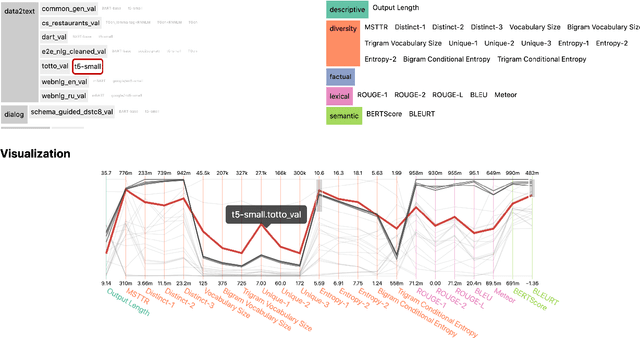
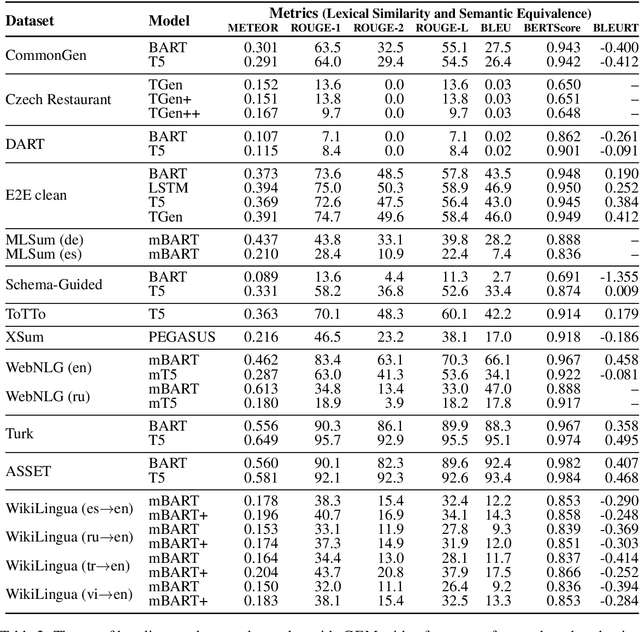
Abstract:We introduce GEM, a living benchmark for natural language Generation (NLG), its Evaluation, and Metrics. Measuring progress in NLG relies on a constantly evolving ecosystem of automated metrics, datasets, and human evaluation standards. However, due to this moving target, new models often still evaluate on divergent anglo-centric corpora with well-established, but flawed, metrics. This disconnect makes it challenging to identify the limitations of current models and opportunities for progress. Addressing this limitation, GEM provides an environment in which models can easily be applied to a wide set of corpora and evaluation strategies can be tested. Regular updates to the benchmark will help NLG research become more multilingual and evolve the challenge alongside models. This paper serves as the description of the initial release for which we are organizing a shared task at our ACL 2021 Workshop and to which we invite the entire NLG community to participate.
 Add to Chrome
Add to Chrome Add to Firefox
Add to Firefox Add to Edge
Add to Edge